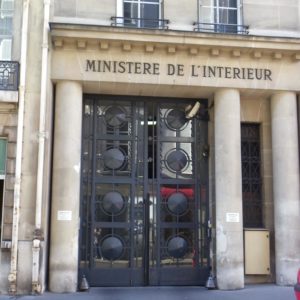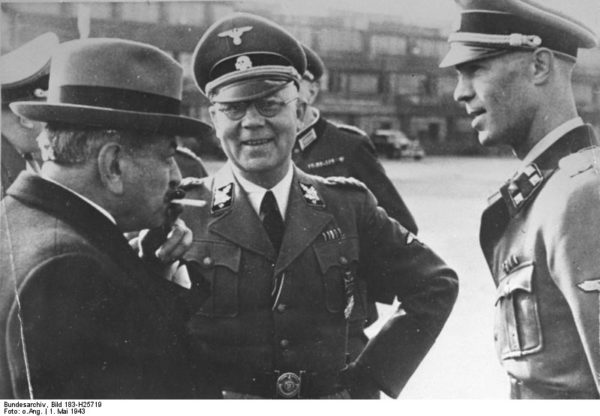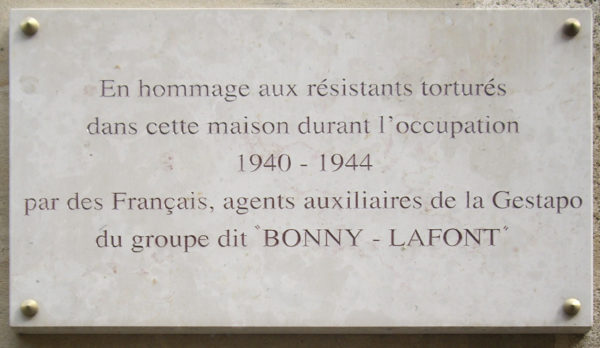On Monday, 22 March 1944, the crumpled and broken body of Pierre Brossolette (1903-1944) lay on the ground outside the building located at 84, avenue Foch in an upscale Parisian neighborhood of the 16th arrondissement (district).
After two and a half days of torture by the Gestapo, Brossolette recovered enough consciousness to determine he was about to divulge information about his colleagues in the French Resistance. He stood up in his cell and flung himself out the sixth floor window. His last words were “all will be fine Tuesday.”
The Street of Horrors

Upon entering Paris on 14 June 1940, the Germans and the various military and civilian units began to immediately appropriate hotels, vacated buildings (many by Jewish citizens), French government buildings, vacant embassies, or just kicked out the existing residents of a building they wanted to occupy.
The different departments of the Nazi police system (commonly grouped under one name: Gestapo) annexed many of the buildings on Avenue Foch. It didn’t take long for the Germans to settle into Paris. The Abwehr (German Intelligence Service) had been operating in Paris during the 1930s and it was clear they had “mapped” out the entire city and identified all potential sites for the Germans to occupy.
The building at 84, avenue Foch became the main headquarters for the Gestapo. The sixth floor was converted to torture rooms and cells. Throughout the Nazi Occupation, the neighbors could hear the screams from the victims of Gestapo torture. Parisians quickly determined this street was not a place you wanted to visit.
Avenue Foch became known to the French as The Street of Horrors.
Police
Over time, the Gestapo and its various units expanded throughout the city. They developed satellite offices, branches, and substations where torture rooms and cells were established. Gestapo agents dressed in suits, wore black trench coats, and drove black cars (presumably Citroëns). Parisians (especially Jewish citizens) learned quickly that a night time knock on their door might lead to bad things happening to members of the family.

By the time Karl Oberg (1897-1965) arrived in Paris in May 1942 as the new HöbererSS and Polizeiführer (chief of all Nazi police activities), approximately 2,400 men served under his command. Despite the need for more men, Oberg was not able to obtain additional forces from Berlin. He didn’t have to. The Vichy government supplemented his forces with several Fascist and anti-Semitic organizations.
French Collaboration
One of the unpleasant facts of the Occupation was the collaboration of certain segments of French society. There were three primary groups that assisted the Germans in rounding up and deporting the Jews (and other “undesirable” groups), fighting the French Resistance, and overall policing in the Occupied Zone, including Paris. A discussion of the collaborationist French media is a subject for another day and blog.
French Police
The French police in Paris carried out much of the heavy lifting for the Germans in regards to arresting and transporting Jews to a deportation camp in Paris known as Drancy (basically this was a holding area prior to boarding the trains to Auschwitz). Their support of German policies and the implementation dwindled as time went on. Because of the police support during the liberation, most of them did not suffer retribution. The police headquarters was (and still is) located on the Île de la Cité at 1, rue de Lutèce.
Milice Française (French Militia) AKA Milice
This was a paramilitary organization created by Pierre Laval (Prime Minister of Vichy France) in 1943. Its purpose was to fight the French Resistance and arrest Resistance members. The primary tactic of the Milice was torture, executions, and the roundups of Jews for deportation. Miliciens were considered more dangerous than the Gestapo and the SS since Milice members were French and it was difficult to identify them. Joseph Darnand (1897-1945), the French leader of the Milice, was granted membership in the SS as an Obersturmführer. The Milice were hated by most of the French and more than 1,500 were executed when liberation took place in August 1944. The rest fled to monasteries and convents in France and Quebec. Headquarters for the Milice was located at 44, rue Peletier.
The Carlingue (French Gestapo)

Also known as the Bonny-Lafont Gang, the Carlingue was called the French Gestapo. Pierre Bonny was a corrupt ex-policeman who teamed up with Henri Lafont, a professional criminal. The Carlingue’s members were criminals recruited from French prisons. The Gestapo formed the organization in 1941 and its primary purpose was to fight the Maquis. Members of the Maquis were young French men who fled to the countryside to evade the forced labor laws. The Carlingue was heavily involved in the black market during the Occupation. The Bonny-Lafont gang/Carlingue operated out of the building located at 93, rue Lauriston. The basement was soundproof with three poles used for the execution of hostages and others. Many of the members of the Carlingue were rounded up during and after the Liberation, tried, and executed.
Gestapo Torture Kitchens
As the Occupation wore on and especially after the Germans invaded Russia, French resistance increased. As resistance activities grew, so did the reprisals by the Germans. If you were arrested for things as menial as a curfew violation, you’d be held in prison as a hostage. When there were actions against the Germans, especially assassinations, they would randomly pick hostages to be executed.
However, many of the arrested foreign agents (e.g., SOE agents), resistance members (e.g., Jean Moulin, Pierre Brossolette), and others deemed as enemies of the Third Reich underwent excruciating torture.
The methods of torture included near drowning, breaking of limbs with a spiked ball, merciless beatings until one fell unconscious, or having fingernails removed with hot irons or other sharp instruments. If the victim didn’t talk (which was rare), they would be shipped off to one of the death camps – survival was rare.
The Gestapo called their torture rooms “kitchens.”
Pierre Brossolette
After Liberation, Brossolette was considered to be the leader of the French Resistance until Charles de Gaulle decided to elevate Jean Moulin to that top spot. After his death, Brossolette’s remains were cremated and his ashes placed in the columbarium at Père Lachaise cemetery. Pierre Brossolette has now been recognized for his role in the French Resistance and given the honor of a final burial spot in the Pantheon – joining Jean Moulin.
We Need Your Help
Please tell your friends about our blog site and encourage them to visit and subscribe. Sandy and I are trying to increase our audience and we need your help through your friends and social media followers.
Thank You
Sandy and I appreciate you visiting with us. We have some exciting things on the horizon and we’ll keep you updated as we go along.
What’s New With Sandy and Stew?
We hope you notice our new logo Stew Ross Discovers. Habib and his team at Locomotion Creative created this for us when we realized that the brand had to target Stew Ross and not Yooper Publications. We really like it because it says “Go out and discover, even if it’s raining.” That is what we’re trying to do with the walking tour books based on historical events and periods of time.
Share This:
Follow Stew:
Find Stew’s books on Amazon and iBooks.
Please note that we do not and will not take compensation from individuals or companies mentioned or promoted in the blogs.
Walks Through History
Copyright © 2016 Stew Ross

Just found your excellent info whilst disagreeing with a book’s info. You have set my mind at rest and now I’m glad the book was wrong because it lead me to you. Thanks kindly people. Bon Chance.